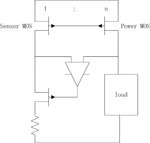chaojixin
Member level 1
Hi, every one!
I'm on the design of a 2.5~4.2V input, 1.8V output, 400mA LDO(CMOS process), and a over-current protection is needed.
What's the most used method in product?
the academic papers usually present a current mirror method as shown in the figure but I think the mismatch is high because the 'n' is always 1000 or even larger. does the product always use this method?
I'm on the design of a 2.5~4.2V input, 1.8V output, 400mA LDO(CMOS process), and a over-current protection is needed.
What's the most used method in product?
the academic papers usually present a current mirror method as shown in the figure but I think the mismatch is high because the 'n' is always 1000 or even larger. does the product always use this method?
Attachments
Last edited:
